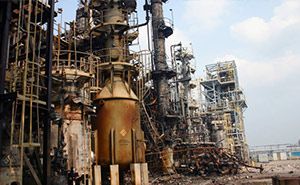An explosion is a rapid increase in volume and release of energy in an extreme manner, usually with the generation of high temperatures and the release of gases. Explosions in a chemical plant need to be avoided at all costs. There are two primary causes of explosions during a chemical process:
- The material is energetically unstable, and has explosive properties. A comprehensive safety study of the process will identify whether materials are sensitive to shock, friction, heat, etc., and may dictate special procedures for safe handling.
- The process could lead to uncontrolled heat or gas generation, resulting in an escape of flammable vapor, or an over-pressurization of the reactor leading to rupture and loss of contents, which may be flammable.
In order to avoid the risk of uncontrolled heat generation, it is imperative that the process is studied using a Reaction Calorimeter in order to determine the Heat of Reaction (enthalpy) and the rate of heat release, so that a process can be designed that minimizes risk of loss of control.














